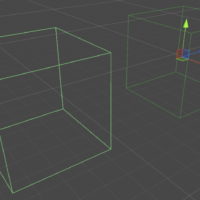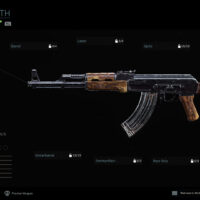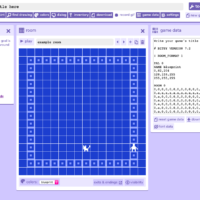Box Collider

Added to the Museum of Data by Shanya Ah-ton on Monday, April 19, 2021. Museum of Data Collection ID: 793.
Public description: Game developers often rely on game engines that come equipped with different features and tools to help facilitate development. One such feature in a popular game enging, the Unity Game Engine, is a box—is a rectangular element with vertices that can be dragged to resize it. How it acts upon other elements in the Unity Game Engine depends on what “Physics Material” is assigned to it. A Physics Material is configured by its own set of variables: dynamic friction, static friction, bounciness, friction combine, and bounce combine. The friction model used comes from the Nvidia PhysX engine and does not necessarily present a close approximation of real-world physics. Thus, object interactions will not necessarily match real world dynamics. Since the Unity Game Engine is a popular game-making engine, the box collider feature has been employed to “materialize” well-known game objects. Crates in Assassin’s Creed and platforms in Hollow Knight are likely made tangible using box colliders, for example. Even entire guns and other complex, in-game objects can be pieced together by combining multiple box colliders.
Materials used: Materially, the box is made of code and pixels on a screen (LCD, glass, plastic, minerals). And on a virtual level, the boxes are made up of physics materials which vary based on user choice.
Credit: Unity engineers created the Unity Game Engine, including all of its colliders, on behalf of Unity Studios.
Copyright: “Unity Technologies ApS (“Unity”) grants to you a worldwide, non-exclusive, no-charge, and royalty-free copyright license to reproduce, prepare derivative works of, publicly display, publicly perform, and distribute the work of authorship that accompanies this License (“Work”), subject to the following terms and conditions: 1. Unity Companion Use. Exercise of the license granted herein is permitted as long as it is in connection with the authoring and/or distribution of applications, software, or other content under a valid Unity content authoring and rendering engine software license (“Engine License”). That means, for example, as long as you authored content using the Work under an Engine License, you may distribute the Work in connection with that content as you see fit under this License. No other exercise of the license granted herein is permitted, and in no event may the Work be used for competitive analysis or to develop a competing product or service. 2. No Modification of Engine License. Neither this License nor any exercise of the license granted herein modifies the Engine License in any way. 3. Ownership; Derivative Works. 3.1 You own your content. In this License, “derivative works” means derivatives of the Work itself--works derived only from the Work by you under this License (for example, modifying the code of the Work itself to improve its efficacy); “derivative works” of the Work do not include, for example, games, apps, or content that you create with the Work. You keep all right, title, and interest in your own content. 3.2 Unity owns its content. While you keep all right, title, and interest to your own content per the above, as between Unity and you, Unity will own all right, title, and interest to all intellectual property rights (including patent, trademark, and copyright) in the Work and derivative works of the Work, and you hereby assign and agree to assign all such rights in those derivative works to Unity. Should assignment be invalid for any reason, you grant to Unity an irrevocable, perpetual, worldwide, non-exclusive, no-charge, and royalty-free license (with the right to grant sublicenses) under those intellectual property rights to those derivative works. You also agree to waive or refrain from asserting any author’s right, moral rights, or like rights to the extent necessary to permit exploitation as contemplated under this License. 3.3 Your right to use derivative works. You will always have the right to use derivative works of the Work you create, consonant with this License. 4. Trademarks. You are not granted any right or license under this License to use any trademarks, service marks, trade names, products names, or branding of Unity or its affiliates (“Trademarks”). Descriptive uses of Trademarks are permitted; see, for example, Unity’s Trademark Guidelines at https://unity3d.com/legal/branding_trademarks. 5. Notices & Third-Party Rights. This License, including the copyright notice associated with the Work, must be provided in all substantial portions of the Work and derivative works thereof (or, if that is impracticable, in any other location where such notices are customarily placed). Further, if the Work is accompanied by a Unity “third-party notices” or similar file, you acknowledge and agree that software or content identified in that file is governed by those separate license terms.”
Language: The customization bar for the box collider is available by default in English, but can be localized into alternative languages. Unity also uses C# by default, with options to add additional programming languages through plugins.
Size: Size is determined by X, Y, Z values. A box collider can occupy a large amount of space within a virtual game world but, materially, cannot escape the bounds of a computer screen.
Creation date: 2005/06/06 00:00:00
Other date: 2005/06/06 00:00:00
Alternate titles: There are none
Alternate identifiers: There are none
External link: https://docs.unity3d.com/Manual/class-BoxCollider.html
Tags: 8

